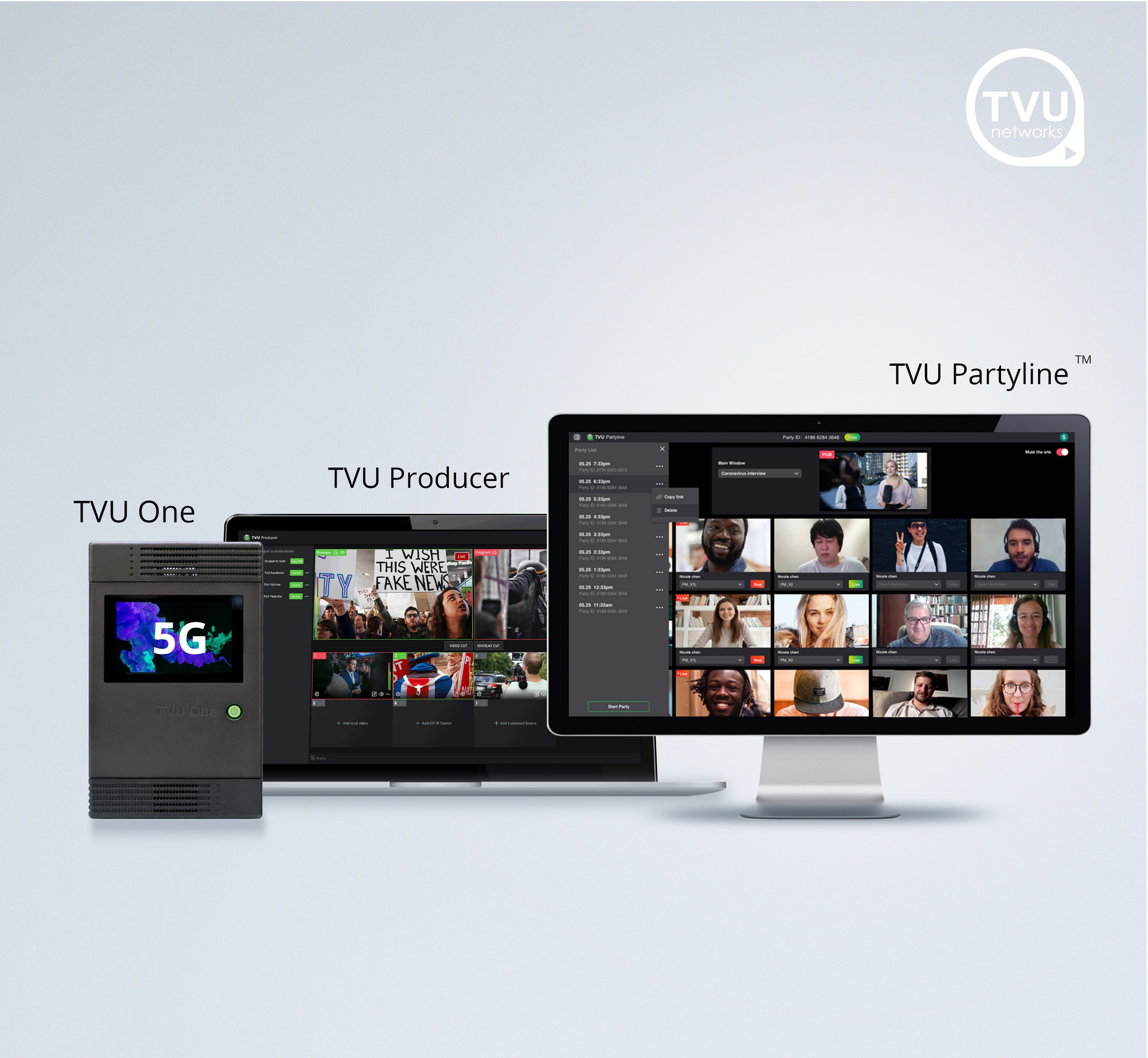Everyone in the live production community around the world was flung into unfamiliar territory in 2020 when the COVID-19 pandemic struck and countries locked down to try to prevent spread of the virus. For many, it became a stark matter of “adapt or perish” in trying to figure out how to pivot away from familiar on-premises workflows to decentralized collaboration among production teams.
Producers, broadcasters and the vendor community that supports them embarked on many new directions. New platforms, as-a-service models and products were spun up and pressed into action to provide ways through the huge challenges created by the COVID-1 restrictions and protocols.
Recently, some of those vendors shared insights into how the media industry has changed and what they’ve learned to the benefit of customers and to the process of electronic media content production heading into 2021.
The IABM selected Telestream’s new GLIM Media Player as a recipient of its BaM Award at its recent BaM Live! event. During the pandemic, GLIM’s development was fast-tracked based on the remote working experiences of Telestream’s customers and staff.
“We see the return of live sports and the use of live streaming, remote production, and IP contribution and distribution growing even more.”
— Samuel Wasserman, LiveU
“While we are tremendously proud that IABM has honored Telestream with its BaM Award for our new GLIM Media Player, it highlights a big issue facing the media industry today. COVID will have a very long-term–perhaps even permanent–impact on the way our industry works,” said Telestream SVP Marketing Scott Murray.
“Both customers and tech vendors must recognize and respect these fundamental changes in working practices and be agile in their response. This will largely influence whether they thrive or survive in the new media landscape,” he said.
“In 2021, I believe we’ll see plenty of teams continuing to work remotely as an ongoing, managed offering to employees,” added Telestream CEO Dan Castles. “In this context, the cloud will be examined for how to accomplish this while at the same time, naturally, there will be continued focus on the economics of cloud-based computing for heavy lifting media workflows,” he said.

“A key component of sustainable remote workflows is not to move the media. If someone needs to QC a program master remotely, waiting two hours for it to download is costly and inefficient. This is one of the reasons that we developed our new GLIM Media Player that allows stakeholders to play full resolution media files remotely from anywhere they have an internet connection,” said Castles.
“Even as vaccines are made available and the pandemic subsides, if companies can save money on travel expenses by not flying every single operator, engineer and supporting equipment to events, they are going to want to do it,” he said.
A Stable Configuration for Complex Workflows and Low Latency
Cloud-based service provider Amagi has released a white paper titled “Cloud Comes Alive for Sports.” In 2020 the company lent its expertise to companies ready to take the plunge into live broadcast in the cloud.
“Cloud originally was not made for real-time video workflows,” explained KA Srinivasan, co-founder of Amagi. “But it has come to a stable configuration where you can run fairly complex workflows with high bandwidth video, and then get that out to viewers with latencies similar or even better than you would have seen with on-premises workflows.”
“COVID-19 forced broadcasters to migrate from a traditional, studio-based production infrastructure to outside-the-box thinking for newscasts and other programming.”
— Paul Shen, TVU Networks
With the recent push forced by COVID-19, broadcasters and producers are realizing they now have access to some new opportunities, with teams able to work remotely from any number of locations. According to the white paper one of the biggest long-term benefits cloud is offering in the current unpredictable world is business agility.
“We recently did a project with a customer who said that if they had tried to launch with a traditional hardware-based set-up, it would have taken a year, or a year and a half, to set up, install, test and validate everything. We went from start to finish in three months,” said Srinivasan.
This kind of agility means a production company or broadcaster can add channels, swap branding and experiment with content when it needs to, spinning up offerings for sports or live events without large capital expenditure costs.
“In pretty much every other business, technology would follow what the business aims were,” Srinivasan continued, “but for broadcast it has been the reverse, with businesses operating within the boundaries set by the technology. The cloud gives those business teams freedom to get out of those constraints. They don’t need to plan five years in advance–they can adapt to whatever the circumstances are.”
Overcoming the Limitations of Typical Video Conferencing Tools
To help its customers navigate through social distancing restrictions and assist with business continuity, TVU Networks rolled out initiatives in 2020 to assist with remote production and remote fan engagement. The company began the year winning a Technical and Engineering Emmy Award for its VoCIP (video over bonded cellular internet technology), but later introduced new and upgraded solutions including TVU Partyline, TVU Producer 3.0 and a TVU One cellular mobile transmitter that was one of the first industry devices shipping with embedded 5G modems.
As COVID-19 began to impact workflows, TVU provided outreach to the broadcast community, as it needed to transition to remote production due to restrictions. When newscasts first moved from studios to living rooms, TVU’s Business Continuity Initiative provided the TVU Anywhere app and other no-cost tools to reporters and anchors forced to abruptly transition to at-home production.
TVU also launched the Project Pool Feed initiative, which let government agencies share critical updates daily regarding efforts to combat the virus with local broadcasters and other media outlets while allowing reporters to respect social distancing requirements. Powered by TVU Grid, government officials shared live video pool feeds and also had the use of free TVU Anywhere app on their mobile phones.

As part of a consortium of technology providers providing the global video pool feed of the first manned commercial SpaceX Falcon 9 rocket launch in May, TVU provided hundreds of media organizations with live access to launch coverage through TVU Grid.
In May, the company also announced TVU Partyline, a collaborative solution for TVU Producer. Designed to support a “social production” paradigm that allows content creators to move beyond traditional studio-based workflows, TVU Partyline’s real-time interactive layer (RTIL) delivers real-time interaction between talent, crew and external content contributors.
“COVID-19 forced broadcasters to migrate from a traditional, studio-based production infrastructure to outside-the-box thinking for newscasts and other programming,” explained Paul Shen, CEO, TVU Networks. “Throughout the year, solutions like our TVU Anywhere app for remote production and TVU Grid for content distribution saw a significant increase in use, while our new TVU Partyline collaboration tool helped broadcasters overcome the limitations of typical video conferencing solutions.
“We are positioned to deliver more cloud-based solutions to even more vertical markets across the globe in 2021,” Shen added. “Internally, we adopted the DevOps process and Jira for project management, allowing us to quickly develop, test and implement customer requests practically overnight.”
Report Confirms Rise in IP for Live Contribution and Distribution
The COVID-19 global pandemic has impacted the way live news, sports, and a variety of other markets have gathered, managed, and disseminated live content. LiveU’s annual “State of Live” report highlights the trends over the past year based on data generated from its global customer base.
Most notable has been the significant increase in content sharing over IP, for US and international viewership. The consolidation of newsgathering efforts and the reduction of on-site staff at live events have increased the reliance on IP-based content contribution and distribution across the globe — from network-to-station, station-to-station, and production crews to sports teams, leagues, and associations.
“Cloud originally was not made for real-time video workflows. But it has come to a stable configuration where you can run fairly complex workflows with high bandwidth video, and then get that out to viewers with latencies similar to or even better than you would have seen with on-premises workflows.”
— KA Srinivasan, Amagi
“Our IP-based technology is inherently suited for remote productions. With the ongoing pandemic and subsequent health, logistical, and budget concerns, our cellular-based portable units have enabled live broadcasts to carry on from home and other locations. At the same time, the move to IP-based workflows has required producers to think differently about the way they create and share live content,” said Samuel Wasserman, LiveU’s CEO and co-founder.
“In the midst of the pandemic, our customers were able to rise above the challenges and deliver content that informed, engaged and entertained viewers,” he added. “As the market hopefully stabilizes with the availability of vaccines, we see the return of live sports and the use of live streaming, remote production, and IP contribution and distribution growing even more.”


